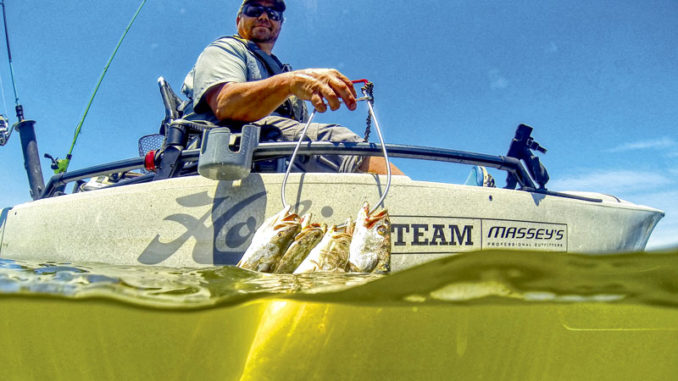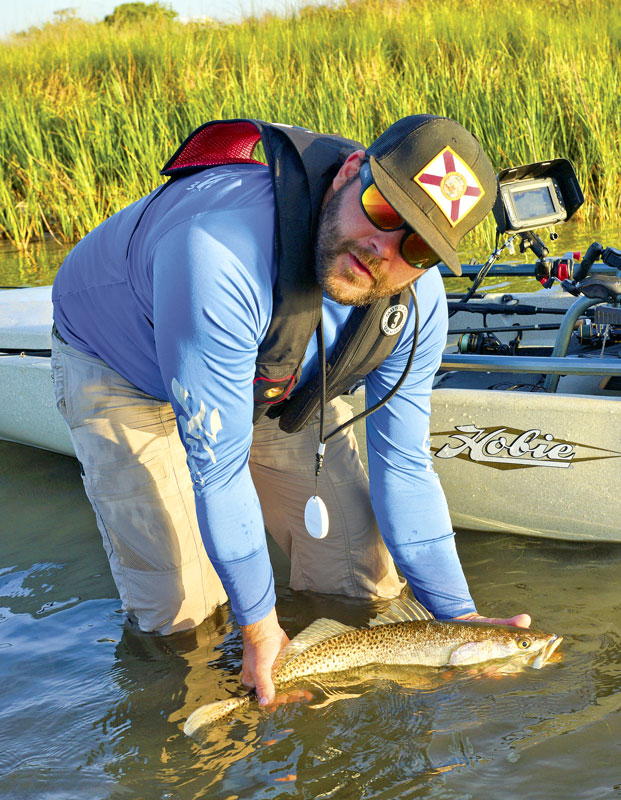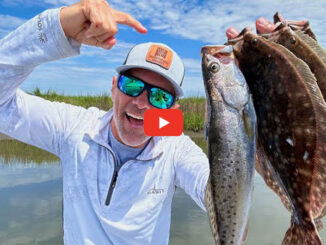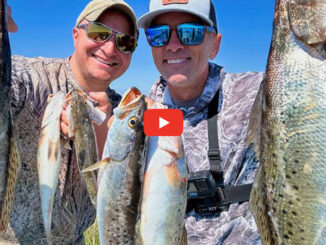
The trout talk this time of year is all about specks moving to the outside to spawn in the saltier waters near the coastline and around barrier islands. While this is generally true, it doesn’t mean that Louisiana’s coastal marshes are devoid of trout, and this is great news for kayakers. Trout can be caught in coastal marshes year-round, and summer offers the widest variety of methods for loading the kayak with speckled deliciousness.
Topwater, live bait, soft plastics, hard plastics, popping cork, tight-lining, trolling and wading are all productive methods for targeting summer specks.
Live bait? In a kayak? Absolutely. Live shrimp are a trout favorite, and taking them aboard a kayak is easier than you might think. Be it a specially make kayak livewell or a simple floating bait bucket, shrimp — or other live bait — can easily be transported on your ’yak.
Live shrimp
Livewells that recirculate water are best for keeping shrimp alive on hot, summer days; however, a simple, small bucket or ice chest with a battery powered air pump does the trick if you don’t overcrowd it. Floating bait buckets also work well but should be put in the kayak when moving from spot to spot to avoid the drag that makes paddling more difficult.
It’s hard to beat a frisky, live shrimp fished under a popping cork or on a bottom rig. Trout are generally found in schools, and if you stay with the school, several fish can be caught in the same location. Once fish are located, you can stretch your live bait supply by having a second rig ready with your favorite jighead and soft-plastic tail and/or hard lure. Switch back and forth between the live and artificial baits to keep the school interested, and go back to live if the bite begins to slow.
There is no more exciting method for tricking a speckled trout than with a topwater plug. The explosion is heart-pounding and, in general, you catch larger trout. Learn to walk-the-dog with your favorite topwater lure, and action is nearly guaranteed. Trout have soft mouths, and the treble hooks can tear free during the fight, so many anglers prefer fishing monofilament for topwater lures as the line stretch gives a little cushion and helps keep them hooked. If you use braid, always use a length of mono leader as a shock absorber.
Wade-fishing
Look for schools of mullet or other baitfish and work the kayak just close enough to make long casts to the edge of the bait. The stealthiness of a kayak allows you to travel with the bait without spooking it as they move along. If you have not tried using topwaters to target speckled trout, you don’t know what you are missing. What you are missing may be your opportunity to catch your personal best trout.

Most inshore areas of south Louisiana are not known for wade-fishing due to the soft, muddy bottoms. However, savvy kayakers will have located several areas with hard sand or shell bottoms where they can step out of the kayak and wade. These are generally found along the banks of larger lakes like Borgne, Calcasieu and Pontchartrain, but there are actually some areas in the marsh where you can get in the shallow water and quietly walk along and cast to unsuspecting trout. Wearing a comfortable PFD while wading is recommended due to the possibility of stepping into a hole or even sinking in soft mud.
Depending on conditions, either stake out the kayak or anchor it to the shore. Wading is highly productive, and the standing position makes working artificial lures easier and more precise. There’s just something about being in the water with the fish that cannot be explained; it must be experienced. It is also quite refreshing on a hot, summer day.
Popping corks
Popping corks with either live bait or soft plastics probably account for more trout hitting the ice chest than any other method. This is mainly due to their effective simplicity. Sure, there are best ways to use a cork, and you will develop more effective rhythms with experience, but simply tossing it out and popping and pausing will generally attract trout. The depth of the lure under the cork and particular popping rhythms change as conditions dictate, but both are easy to figure out with a little experimentation and noting what is working best in a given situation.
Trolling
Do not overlook trolling. Kayaks make great platforms for trolling lures or live bait. Their slow, quiet movements allow you to drag baits along without spooking fish. Actively trolling a line or two is a great way to catch and locate speckled trout. Even if you are fishing your way down a shoreline or simply just moving from spot to spot, trolling a lure or even a cork behind you is a great way to catch a couple of bonus fish.
Birds
Don’t overlook the birds. If you see birds, particularly seagulls — terns lie! — quietly work your way just close enough to the action. Chances are that a school of trout has shrimp herded up, and as the shrimp attempt to flee to the surface, the birds provide a double-whammy from above. Cast directly into the frenzy, and instant action is nearly guaranteed. Quietly drifting with the school can provide plenty of non-stop action.
There is no better time than now to chase trout in the kayak. The fish are plentiful, hungry, and easy to catch using a wide variety of baits and techniques.


